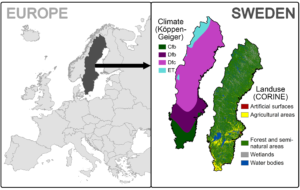Sweden
Sweden is a country in northern Europe bordered by Norway in the west, the North Sea in the southwest, the Baltic Sea in the east and Finland in the northeast. Sweden has a land area of approximately 408,000 km2 [1] with elevations ranging from -2 to 2100 m.a.s.l..

 Climate
According to the Köppen-Geiger classification[2], Sweden stretches over four different climate classes: Southern Sweden is located within the oceanic climate zone (Cfb) with warm summers and cool winters, Central Sweden is part of the subpolar oceanic climate zone (Cfc) with cool summers and cool winters, northern Sweden experiences a subarctic boreal climate (Dfc) with cool summers, very cold winter, persistent seasonal snow cover and soil frost during winters, and the Scandinavian Mountains in Northwestern Sweden are located in the polar tundra climate zone (ET) with monthly mean temperatures below 10°C. During the period 1961-2010, the annual mean temperature was 2.5°C while the annual precipitation averaged 733 mm.
 Land cover
About 69% of the land area are covered by forest[1], 9% by wetlands, 8% by shrubs and grass land, 8% by agriculture (mostly in southern Sweden, cf. ), 3% by human settlements and the remaining 3%Â are open land.
References:
[1] SLU (2015), Forest statistics 2015, Official Statistics of Sweden, Swedish University of Agricultural Sciences (SLU), Umeå, Sweden.
[2] Kottek, M., J. Grieser, C. Beck, B. Rudolf, and F. Rubel (2006), World map of the Koppen-Geiger climate classification updated, Meteorol Z, 15(3), 259–264, doi:10.1127/0941-2948/2006/0130.